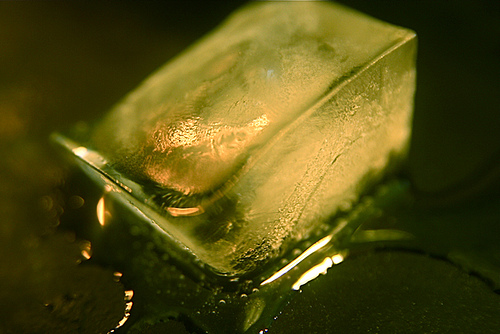
This is a melting ice cube, in case you forgot what “melting” is. (Photo by Steven DePolo.)
A recent estimate from climate researchers suggested that the melting of Arctic sea ice could result in the warming equivalent of 20 years of CO2 emissions, due largely to the loss of huge swaths of the color white. White, you’ll remember from elementary school, reflects light — including sunlight. More white means less absorbed heat.
Other researchers made another discovery: On-land snow is also white. From NPR:
A study by Canadian researchers finds that springtime snow is melting away even faster than Arctic ice. That also has profound implications for the Earth’s climate.
Springtime snowmelt matters a lot: It determines when spring runoff comes out of the mountain to fill our rivers. And Chris Derksen at Environment Canada in Toronto says snow also reflects sunlight back into space, helping to keep the Earth from heating up too fast.
“When you remove the snow cover form the land surface, much as when you remove the sea ice from the ocean, you take away a highly reflective, bright surface, and you expose the bare land or tundra underneath, and that absorbs more solar energy,” he says.
What’s worse is that the decline of springtime snow is happening faster than that of Arctic ice. The Environment Canada team calculated that snowmelt is declining at 18 percent per decade, compared to 11 percent for the ice cap.
And what’s even worse is that the snowmelt is only the first layer of the problem. Beneath the snow is the permafrost, which is no longer as “perma.” Thawing permafrost, as we’ve mentioned before, releases methane into the atmosphere, contributing more to warming than the same amount of carbon dioxide.
Oh, and the thawing/warming process makes everything drier, meaning more forest fires. That’s not worse than the permafrost, though.
And now a spot of good news.
But there’s one big difference between snowmelt and the sea ice melt. Because the sea ice is getting thinner and less resilient every year, it seems inevitable that the melting trend will continue. But Mote says the long-term buildup of greenhouse gases may not be the whole story for spring snowmelt.
“The atmosphere and the ocean do different things year to year, and that can also affect the snow cover in ways that are independent of greenhouse gases,” he says.
So Mote is not so sure this dramatic trend of recent years will keep on its downward spiral.
Then I’m not even going to worry about this.



